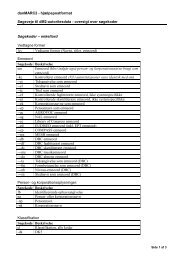RFID Data Model for Libraries - biblstandard
RFID Data Model for Libraries - biblstandard
RFID Data Model for Libraries - biblstandard
Create successful ePaper yourself
Turn your PDF publications into a flip-book with our unique Google optimized e-Paper software.
<strong>RFID</strong> <strong>Data</strong> model <strong>for</strong> libraries Doc 067<br />
Ordinal part number<br />
‘Ordinal part number’ is used <strong>for</strong> media package handling. ‘Ordinal part number’ identifies<br />
the <strong>RFID</strong> tag at each item in a media package or the only one tag <strong>for</strong> a package.<br />
A general tendency can be observed to produce circulation items containing more than one<br />
part. A CD with a booklet. A double CD. A book containing a CD ROM and a piece of plastic<br />
as a template <strong>for</strong> something. This has always been an added complexity in a circulation<br />
department. With self service devices this is only handled with a limited security in bar code<br />
based application. This issue may be the decisive element <strong>for</strong> changing to <strong>RFID</strong> based<br />
applications.<br />
For each of these elements one byte is set aside. This gives a possibility to control a media<br />
package of 256 elements. This could be observed as an overdoing. However, the more simple<br />
solution of half a byte gives only an option of 16 elements. Several vendors are close to that<br />
limit already.<br />
Primary item ID<br />
The primary item ID is a unique identification of an item in the library. This will typically be<br />
a transfer of the ID that today is on the bar code.<br />
The primary ID is specified to a maximum of 16 characters. The length of 16 characters is<br />
based on the experience of the members of the working group. An example of a bar code<br />
system using 27 characters has been found. There<strong>for</strong>e a method <strong>for</strong> long IDs can be found in<br />
the data model in Part 3.<br />
Cyclic Redundancy Check (CRC)<br />
To ensure safety in reading a data element of selfchecking is introduced. This is specified as a<br />
16 bit CRC <strong>for</strong> the mandatory starting block. The CRC itself is excluded from this<br />
calculation.<br />
The CRC is a very powerful but easily implemented technique to obtain data reliability. The<br />
CRC technique is used to protect blocks of data called Frames. Using this technique, the<br />
transmitter appends an extra n- bit sequence to every frame called Frame Check Sequence<br />
(FCS). The FCS holds redundant in<strong>for</strong>mation about the frame that helps the transmitter detect<br />
errors in the frame. The CRC is one of the most used techniques <strong>for</strong> error detection in data<br />
communications and has the following qualities:<br />
• High error detection capabilities.<br />
• Little overhead.<br />
• Ease of implementation.<br />
See an example of CRC calculations in Annex D: Example of CRC calculations<br />
Country of Owner library<br />
Two-character country code as specified in ISO 3166-1 Alpha-2.<br />
15




